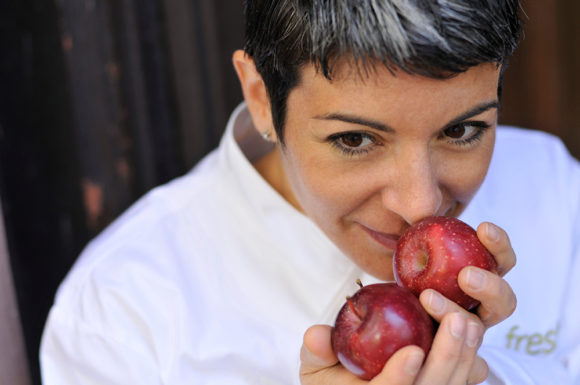Culinary School Instructor Molds The Next Generation of Chefs
By Darren Atkins

From an early age Chef Erica Wides had an obsession with food; she would painstakingly craft and sculpt miniature fake representations of food, housing them alone in her doll house. Now an instructor at The Institute of Culinary Education (www.iceculinary.com), Wides is now sculpting the next generation of chefs and teaching them how to carve their own niche in food.
Wides took a while, as most people do, to find her own niche. As a young woman she attended the School of Visual Arts (www.schoolofvisualarts.edu to study art and photography. In her final years of college, her artwork and photography started to incorporated food; Wides created still lives out of food with a political/feminist theme and then photographed them. She remarks, “I guess I was working a few things out through my work.”
Her explorations in college led her to pursue her career dreams of being a photographer in New York, but she quickly realized it was an expensive and difficult way to make a living here and so she took stock of the situation and realized that she didn’t have anything else, but her love for food. So, she did what every other struggling artist does in New York, at some time or another- she waited tables. While doing that, Wides realized she was much more interested in what was going on behind the scenes. But then, something happened that would force her to make a change. Wides explains, “I was waiting tables and thinking about food a lot, and then all of my photography equipment got stolen. I saw it as a sign that maybe it was time to change careers, maybe I should forget about the photography and just concentrate on the food.”
Wides’ first food love was pastry, but she enrolled in the New School’s 6 week basic culinary program, deciding that it would give her a more rounded background in food. Upon graduation she was offered a position as a line chef by Alan Harding, chef/owner of the now closed Nosmo King, a restaurant that, before the ban on smoking in restaurants officially went into effect, already offered a unique smoke free dining experience. Wides moved on from Harding’s kitchen and continued, for the next six years, to hone her skills in various restaurants including Harvest, Savoy and Arcadia.
The transition from being on the line every day to teaching happened by accident; Wides fell into it, after taking some time off from a heavy workload of a rigorous New York schedule and summers spent working in Maine. She remembers, “I got burned out and decided to take a break and teach for a while. 15 years later I was still teaching made me much happier than working in restaurants, so that was fine for me.”
Over those 15years, Wides has seen many changes in the culinary field. Some easier to embrace than others as she’s been an instructor at ICE. When she began teaching there the backbone and direction of every culinary curriculum was Masters of French Cooking 101and Wides found it difficult to adapt to the curriculum- she had spent too much time working in contemporary American restaurants. Wides admits, “I was one lesson ahead of the students-really! I didn’t know any of that French stuff. Now thankfully over the years we’ve adapted and modernized our curriculum to include Asia, Italy and Latin cuisine.”
As Wides and ICE changed, so did her student population; at the beginning of her teaching career people were entering chef programs armed with solid college degrees and educational experience. All of this was required at the time. Today students are coming straight from high school with little or no food knowledge, often in the hopes of turning a blue collar profession into a glamorous one. Maureen Drum Fagin Director of Career Services at ICE says, “Culinary school graduates today can go a in a broad range of career directions. With the right combination of training, hands-on experience and drive, today’s emerging professionals can find work in traditional venues, such as restaurants and hotels, as well as alternative fields like test kitchens, online food sites and personal cheffing.”
Culinary schools in general lowered their academic requirements over the years in order to receive a broader student body. Wides notes, “The students back then came from affluent families and were more worldly and familiar with food, now our students are right out of high school and are coming too me with no experience in food other than eating at chain restaurants, and watching the Food Network.”
The change in the culinary school’s policies, and the diminished availability of industrial and factory jobs, made the culinary industry become a more, appealing, exotic and exciting alternative to a lot of youth. Particularly as they grew up in an age with celebrity superstar chefs and Food Network big shots, glamming it up on awards shows like Academy award winning Hollywood actors. Says Wides, “People are dreaming and realizing that it can be an exciting and viable career, and with the restaurant industry exploding in this country, there is more need for labor.”
Wides’ passion for teaching shows through in her bubbly personality and contrasting tenacity as she gets the message out there that the culinary industry can be an obtainable career goal for many young people passionate about food-and in doing so they can be rewarded with a great treasure. Recently Wides joined the staff of Heritage Radio Network (www.heritageradionetwork.com) to continue teaching in a different capacity-there she hopes to promote sustainably raised breeds of animals and foods obtained from independent growers, to consumers around the country.
With this new role it is evident that Wides’ passion for sculpting food and the way it is approached hasn’t diminished, it’s just expanded even further beyond the doors of her dollhouse.

